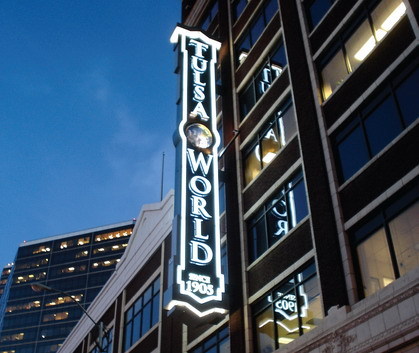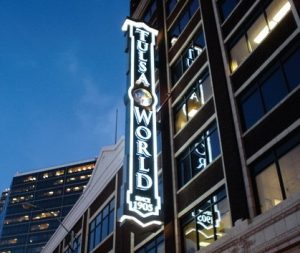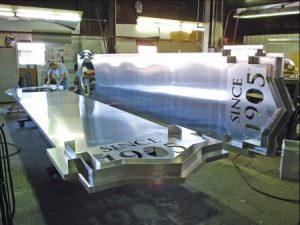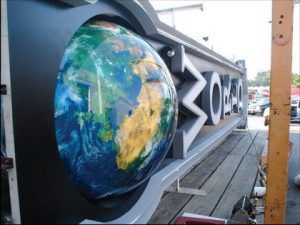LEDs + Lighting
What a World!
Tulsa’s Claude Neon celebrates the local newspaper’s anniversary.
Published
16 years agoon

The Tulsa World, one of the last privately owned newspapers in the United States, approached us about creating signage to commemorate its 100th anniversary. Gary Larsen, our account executive, and I met with Robert Lorton III, owner of the World Publishing Co., who envisioned a landmark-style sign. For inspiration, he provided photos of the building’s original signage, which was installed in the late 1920s. However, little record of the original signs existed – for unknown reasons, the building’s original sign was removed in the ’50s.
World Publishing chose Claude Neon Federal (CNF) Signs for the project because they liked the resto¬ration job we com-pleted for the Atlas Life building sign at the just a few blocks from the World’s office. They also appreciated our 81-year presence in our market.
Lorton didn’t want to stifle our creativity – he only asked us to use the World’s logo font, Trajan, to create a unique blade sign that somewhat resembled the original. Sign designers rarely receive that much creative freedom, so we attack these rare opportunities with extra vigor.
Ideas to paper
As soon as we left the meeting, I developed sketches with one feature I knew we had to incorporate – a 360° globe that rotates on an angled axis. I began searching the web for a company that could fabricate my envisioned elements. We chose Capital Plastics (Beltsville, MD). Capital’s Tim Sullivan explained the company had created similar globes for the Discovery Channel stores. Although the Discovery globes were smaller than the 4-ft.-diameter globes our plans required, he affirmed Capital could handle the job.
Confident in our plans, we started the design process. I devised pencil sketches to develop a rough layout. I created several sketches and narrowed the contenders down to two versions to show the client.
AdvertisementUsing Adobe® Illustrator®, I experimented with scale and shape. Our design department uses Macs exclusively, as well as CADtools®, an Illustrator plug-in that allows efficient creation of scaled and measured drawings.
Because they extend over the city’s right-of-way, all projecting signage requires a variance. To meet city officials’ needs, we decided upon a 7-ft. projection and 45-ft. overall height. I exported my Illustrator drawing into Google SketchUp Pro to create 3-D models. The architectural field widely uses SketchUp to quickly render building concepts; it’s very easy to learn and use, so I’ve adapted it for signage. The program enables renderings to show many different views with realistic shadows and shading in many preset “sketch modes” that resemble hand-drawn, pen or marker-style models.
I developed numerous angles before we presented our proposals to the client. Fabrication began immediately after they made their decision.
Top of the world, Ma!
Capital Plastics began its globe fabrication by producing a high-resolution graphic that melded Earth satellite photos. They laminated digitally printed graphics and applied them to clear acrylic before heat-forming them into two half-spheres. They joined the two halves with a wooden, internal, wheel-shaped structure, which also guides a steel tube through the north-south pole axis.
AdvertisementLater, we mounted the globe to a custom-support structure that comprises ball bearings at the lower mount and a DynaPac rotator at the top. We mounted the globe within the sign on a 23.5° angle that mimics the Earth’s rotation.
Cabinet creation
We began the cabinets’ structural work by routing the sign’s profile shapes on our 6 x 10-ft. MultiCam MG CNC router. The metal shop aligned these pieces to a full-size paper template and began welding the various parts together. Because the 45-ft.-tall sign would be difficult to handle within the shop, and during transportation to the install site, we decided to divide the sign into two halves.
Using heavy-gauge, .125-in.-thick aluminum, we created a solid, flat face that supported the unique, reverse-lit channel letters we’d later attach. To create this sign, we somewhat reversed the usual fabrication order by assembling the two sign faces before building a 20-in.-deep, steel-frame filler to connect them.
For the neon channel that surrounds the sign, we welded 4-in.-deep .063-in.-thick aluminum returns to the face rather than fabricating the channel separately and attaching it mechanically. This saved fabrication time while adding structural strength to the face.
Several shades of white neon provide accent illumination. For channel illumination, our inhouse neon department chose EGL 6500K, whereas 4500k neon bands wrap the sign’s ends to soften and add warmth to the lighting.
AdvertisementWe decided multi-colored neon would clash with the professional look we wanted the signs to convey. We created a grayscale paint scheme that prompted mental cues of a newspaper’s traditional “black and white” appearance. We mixed Matthews acrylic-polyurethane paint into four separate shades of grey and black to coat the sign with a satin finish.
Tuning the channel
The channel letters’ unique design required 50% inspiration and 50% necessity. Trajan’s a classical font whose narrow serifs can complicate standard letter production. I’d been waiting for an opportunity to incorporate a push-through face into reverse channel letters, and this was it.
In order to thicken the letter stroke to accommodate the 8300K, white-neon backlighting, we created an offset path that allows the push-through face to remain true to the font design. The bold background also separates the face illumination from the halo lighting.
We routed the faces from ¾-in.-thick, clear acrylic and then laminated them with 3M’s 3630-20 white, translucent white vinyl on the face and second-surface 3M 3635-70 white, diffuser vinyl. This divides the light between the face and reflects it back for a halo-like glow. We tried several setups before we found the right balance. Once perfected, our inhouse neon department output several patterns using Aries Graphics’ Neon Wizard software.
We chose a somewhat narrow sign filler to allow enough of the globe to protrude through both sides of the sign. The narrow depth, coupled with the large steel structure, required us to hang the sign from the building, which caused concerns about service access and transformer location. We chose weatherproof, low-profile, France transformers, which we face-mounted inside the letters to solve this dilemma. The letters can be easily removed to access neon and transformers for service.
The sign’s bottom section features push-through text that trumpets the World’s existence “since 1905.” We backlit the text with high-output, fluorescent lamps.
Built to last
Installation on older buildings is always a challenge. Older buildings carry the unknown – documentation is often sketchy, and original concrete and brickwork is unstable and brittle at best – and this display was no different. Fortunately for us, the building had undergone extensive renovations over the past few years, and recent architectural drawings were available.
We installed the flag-mounted sign without guide wires. I’ve always hated how wires look when crossing a sign’s text. They’re distracting and make the signs appear weak. Oklahoma springs routinely bring 20- to 30-mph winds, and gusts can approach 100 mph. The mounting required engineering drawings that ensured sufficient wind load.
The building features a brick curtain wall and concrete pylons within. We hired a masonry expert to carefully remove the building’s original brick at the three attachment points. Then, we mounted 10 x 14-in., heavy wall tubes to the interior column with ½-in.-thick, steel plates and Hilti epoxy anchors. We then re-installed the bricks around the support pylons in preparation for the final install.
Thanks to our prior preparations, we installed the sign seamlessly. We raised its lower half and slipped it onto the lower, twin support tubes. Next, we welded the frame and bolted it through the pylon. Aligning the top half’s upper tube with the lower half proved time-consuming, but we still completed the entire installation in one day.
The sign became the centerpiece of the paper’s 100th-anniversary issue and covered the entire front page. It is a local landmark that we hope will endure for the next century.
More About Joe and Claude Neon Federal
Joe Kesterson is Claude Neon Federal Signs’ (Tulsa, OK) senior designer and project manager. Joe went straight from graphic design school to work in the signage industry 12 years ago because he noticed a shortage of trained designers. He took a break from the sign-manufacturing arena while working as a production designer for fd2s, a Houston-based, environmental-graphic design firm. There, he focused upon wayfinding, identity signage and project management. Kesterson “returned to his roots” when he joined Claude Neon Federal (CNF) four years ago. He currently serves as senior designer and project manager.
Georges Claude, father of the neon tube, sold franchising rights to Federal Sign and Signal in the early 1900s to produce his product in the United States. CNF’s Tulsa branch opened in 1926. Initially, Tulsa and Oklahoma City operated as sales offices for the company’s Wichita, KS-based manufacturing facility. However, Tulsa later gained its own manufacturing facilities and became privately owned in 1955, which it remains today.
CNF’s team comprises approx¬imately 60 people, many with 20-plus years of experience. The company operates nine crane trucks with operational ranges from 60 to 120 ft., as well as three, full-time, service rigs. Construction has begun for CNF’s new, 33,000-sq.-ft. manufacturing facility that’s scheduled
Equipment and Materials
Channel Letters: ReturnShop® GTO channel-letter notcher, from Arete Corp.. (Denver), (800) 728-1453 or www.aretecorp.com; ¼-in.-thick Acrylite acrylic, from Evonik Degussa USA (Theodore, AL), (251) 443-4000 or www.degussa.com; and custom-made, aluminum returns.
Globe: Globe fabricated by Capital Plastics (Beltsville, MD), (301) 595.1177 or www.capitalplasticsco.com; mechanical rotator, from DynaPac Rotating Co. (Salt Lake City), (800) 657-2650 or www.dynap¬acrotating.com.
Neon: Electronic transformers, from France, a Scott Fetzer Co. (Fairview, TN), (615) 799-0551 or www.franceformer.com; neon tubing, from EGL (Newark, NJ), (908) 508-1111 ; Maxi-Vax EXV50 neon pumping station, from EGL.
Paint: Acrylic-polyurethane paint and primer, from Matthews Paint. (Pleasant Prairie, WI), (800) 323-6593; W-400 industrial spray gun, from Iwata-Medea Corp. (Portland, OR), (503) 253-7308 or www.iwata-medea.com.
Plotter: SummaCut 54-in. cutting plotter, from Summa Inc. (Seattle), (800) 527-7778 or www.summausa.com.
Router: MG Series 6 x 10-in. router table, from MultiCam Inc. (Dallas-Ft. Worth Airport, TX), (972) 929-4070 or www.multicam.com.
Software: EnRoute 3 3-D software, from Wayne Industries. (Philadelphia), (800) 229-9066 or www.enroute3.com; Omega™ software, from Gerber Scientific Products (South Windsor, CT), (800) 222-7446 or www.gspinc.com; FlexiSign™, from SA Intl.; Neon Wizard, from Aries Graphics (San Marcos, CA), (800) 294-7273 or www.aries-graphics.com.
Vinyl: Translucent and diffuser vinyl, from 3M Graphics Market Center (St. Paul, MN), (888) 364-3577 or www.3m.com.
SPONSORED VIDEO
Introducing the Sign Industry Podcast
The Sign Industry Podcast is a platform for every sign person out there — from the old-timers who bent neon and hand-lettered boats to those venturing into new technologies — we want to get their stories out for everyone to hear. Come join us and listen to stories, learn tricks or techniques, and get insights of what’s to come. We are the world’s second oldest profession. The folks who started the world’s oldest profession needed a sign.
You may like
Advertisement
Subscribe

Magazine
Get the most important news
and business ideas from Signsofthetimes Magazine.
Advertisement
Most Popular
-

 Tip Sheet2 weeks ago
Tip Sheet2 weeks agoAlways Brand Yourself and Wear Fewer Hats — Two of April’s Sign Tips
-

 Photo Gallery4 days ago
Photo Gallery4 days ago30 Snapshots of the 2024 ISA Sign Expo
-

 Ask Signs of the Times6 days ago
Ask Signs of the Times6 days agoWhy Are Signs from Canva so Overloaded and Similar?
-

 Real Deal2 weeks ago
Real Deal2 weeks agoA Woman Sign Company Owner Confronts a Sexist Wholesaler
-

 Paula Fargo1 day ago
Paula Fargo1 day ago5 Reasons to Sell a Sign Company Plus 6 Options
-

 Benchmarks1 week ago
Benchmarks1 week ago6 Sports Venue Signs Deserving a Standing Ovation
-

 Photo Gallery1 day ago
Photo Gallery1 day ago21 Larry Albright Plasma Globes, Crackle Tubes and More
-

 Women in Signs2 weeks ago
Women in Signs2 weeks ago2024 Women in Signs: Megan Bradley













